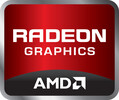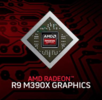Intel UHD Graphics P630 vs AMD Radeon R9 M365X vs AMD Radeon R9 M390X
Intel UHD Graphics P630
► remove from comparison
The Intel UHD Graphics P630 (GT2) is a professional integrated graphics card, which can be found in various Xeon desktop and notebook processors of the Coffee-Lake generation. The "GT2" version of the GPU offers 24 Execution Units (EUs) and the clocks depend on the CPU model. Due to its lack of dedicated graphics memory or eDRAM cache, the UHD P630 has to access the main memory (2x 64-bit DDR3L-1600 / DDR4-2133). Compared to the older HD Graphics P630 (Kaby-Lake), the newer UHD GPU is identical but can be clocked slightly higher. Compared to the regular UHD 630, the P630 supports ECC main memory and is intended for professional applications.
Performance
The exact performance of the UHD Graphics P630 depends on various factors like TDP, L3 Cache, memory (DDR3/DDR4) and maximum clock rate of the specific model. However, it should be fairly similar to the HD Graphics 530 and HD Graphics 630 and therefore only suited for low demanding games like Overwatch or Farming Simulator 2017 (low details).
Features
The features of the UHD P630 are the same as for the HD 630 and therefore H.265/HEVC Main10 profile at 10-bit color depth are supported in hardware. Furthermore, HDCP 2.2 is also supported in all chips, which allows Netflix 4K videos, for instance. HDMI 2.0 however is still only supported with an external converter chip (LSPCon).
Power Consumption
The UHD Graphics P630 can be found in several notebook and desktop processors of different TDP classes.
AMD Radeon R9 M365X
► remove from comparison
The AMD Radeon R9 M365X is a mid range DirectX 12 compatible graphics card for laptops. It is based on the GCN architecture and manufactured in 28nm. The older Radeon R9 M270 and the current Radeon R9 M370X are very similar (see for gaming benchmarks).
The R9 M365X uses 640 shader cores (10 compute units) clocked at 925 MHz (max.) and supports according to the AMD website 4 GB GDDR5 at 1125 MHz (4 GHz effective). The only used version in a Toshiba laptop so far however only uses 2 GB GDDR5.
AMD Radeon R9 M390X
► remove from comparison
The AMD Radeon R9 M390X is a mobile high-end graphics card for laptops. It is most likely based on the same chip as the AMD Radeon R9 M295X in the iMac 5K Late 2014. That means it should be based on the third generation of GCN (desktop Tonga chip). The amount of shader cores is identical but the core clock is reduced by 15% (from 850 MHz to 723 MHz) and the memory is also clocked slower (5448 MHz vs 5000 MHz).
The performance should be a bit below the M295X. Compared to the competition, the R9-M390X should be positioned somewhere between the GeForce GTX 965M and 970M and therefore suitable for high-end games in 1080p resolution and high detail settings.
The card was first mentioned by Alienware on their twitter account and should feature 4GB VRAM according to the tweet.
The power consumption should be rated around 100 Watt TDP and therefore suited only for large and bulky laptops (like the Alienware M17x it was announced in).
| Intel UHD Graphics P630 | AMD Radeon R9 M365X | AMD Radeon R9 M390X | ||||||||||||||||||||||||||||||||||||||||||||||||||||||||||||||||||||||||||||||||||||||||||||||||||||
| Radeon R9 M300 Series |
|
|
| |||||||||||||||||||||||||||||||||||||||||||||||||||||||||||||||||||||||||||||||||||||||||||||||||||
| Codename | Coffee-Lake-GT2 | Amethyst (XT) / Tonga | ||||||||||||||||||||||||||||||||||||||||||||||||||||||||||||||||||||||||||||||||||||||||||||||||||||
| Architecture | Gen. 9.5 | GCN | GCN 3 | |||||||||||||||||||||||||||||||||||||||||||||||||||||||||||||||||||||||||||||||||||||||||||||||||||
| Pipelines | 24 - unified | 640 - unified | 2048 - unified | |||||||||||||||||||||||||||||||||||||||||||||||||||||||||||||||||||||||||||||||||||||||||||||||||||
| Core Speed | 300 - 1200 (Boost) MHz | 900 - 925 (Boost) MHz | 723 (Boost) MHz | |||||||||||||||||||||||||||||||||||||||||||||||||||||||||||||||||||||||||||||||||||||||||||||||||||
| Memory Bus Width | 64/128 Bit | 128 Bit | 256 Bit | |||||||||||||||||||||||||||||||||||||||||||||||||||||||||||||||||||||||||||||||||||||||||||||||||||
| Shared Memory | yes | no | no | |||||||||||||||||||||||||||||||||||||||||||||||||||||||||||||||||||||||||||||||||||||||||||||||||||
| API | DirectX 12_1, OpenGL 4.4 | DirectX 12, Shader 5.0, OpenGL 4.4 | DirectX 12 (FL 12_0), Shader 5.0, OpenGL 4.3 / Vulkan | |||||||||||||||||||||||||||||||||||||||||||||||||||||||||||||||||||||||||||||||||||||||||||||||||||
| technology | 14 nm | 28 nm | 28 nm | |||||||||||||||||||||||||||||||||||||||||||||||||||||||||||||||||||||||||||||||||||||||||||||||||||
| Features | QuickSync | Mantle, PCIe 3.0, Zero Core, PowerTune | DirectX 12, OpenCL 1.2, OpenGL 4.3, Vulkan, Mantle | |||||||||||||||||||||||||||||||||||||||||||||||||||||||||||||||||||||||||||||||||||||||||||||||||||
| Date of Announcement | 01.10.2017 | 06.05.2015 | 09.06.2015 | |||||||||||||||||||||||||||||||||||||||||||||||||||||||||||||||||||||||||||||||||||||||||||||||||||
| Memory Speed | 4500 MHz | 5000 MHz | ||||||||||||||||||||||||||||||||||||||||||||||||||||||||||||||||||||||||||||||||||||||||||||||||||||
| Memory Type | GDDR5 | GDDR5 | ||||||||||||||||||||||||||||||||||||||||||||||||||||||||||||||||||||||||||||||||||||||||||||||||||||
| Max. Amount of Memory | 4 GB | 4 GB | ||||||||||||||||||||||||||||||||||||||||||||||||||||||||||||||||||||||||||||||||||||||||||||||||||||
| Notebook Size | medium sized | large | ||||||||||||||||||||||||||||||||||||||||||||||||||||||||||||||||||||||||||||||||||||||||||||||||||||
| Power Consumption | 125 Watt | |||||||||||||||||||||||||||||||||||||||||||||||||||||||||||||||||||||||||||||||||||||||||||||||||||||
| Transistors | 5 Billion |
| ||||||||||||||||||||||||||


 Deutsch
Deutsch English
English Español
Español Français
Français Italiano
Italiano Nederlands
Nederlands Polski
Polski Português
Português Русский
Русский Türkçe
Türkçe Svenska
Svenska Chinese
Chinese Magyar
Magyar